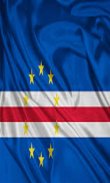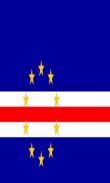







Cape Verde Flag

Beschreibung von Cape Verde Flag
The national flag of Cape Verde was adopted on September 22, 1992, replacing the flag adopted during Cape Verdean independence, fought for with Guinea-Bissau, another former Portuguese colony on mainland West Africa.
The 10 stars on the flag represent the main islands of the nation (a chain of islands off the coast of West Africa). The blue represents the ocean and the sky. The band of white and red represents the road toward the construction of the nation, and the colours stand for peace (white) and effort (red). The yellow colour, circular formation of the stars, and dark blue field show similarity to the flag of Europe with 12 stars instead of 10, originally designed for the Council of Europe, but also used by the European Union. The stripes are in 6:1:1:1:3 ratio, and the circle of stars is centred 3/8 along the fly.
Despite its remoteness in elevation with all but 3 islands being mountainous, the lack of natural resources, its isolation from many other countries, and devastating famines in the later 20th century, Cape Verde has won a positive reputation in promoting what is considered the most stable democracy in Africa, a standard of living higher than most African nations, and one of the most politically liberal nations on the continent, and in the world.
Cape Verde (pop. 506,000) is located 500 km from the west coast of Africa. The once uninhabited islands were discovered and colonized by the Portuguese in the 15th century; they subsequently became a trading center for African slaves and later an important coaling and re-supply stop for whaling and transatlantic shipping. Independence was achieved in 1975.
Die Nationalflagge von Kap Verde wurde am 22. September 1992 angenommen und ersetzt die Flagge während kapverdischen Unabhängigkeit kämpften mit Guinea-Bissau, einem anderen ehemaligen portugiesischen Kolonie auf dem Festland Westafrika angenommen.
Die 10 Sterne auf der Flagge stellen die Hauptinseln der Nation (eine Kette von Inseln vor der Küste von Westafrika). Das Blau steht für das Meer und den Himmel. Die Band von Weiß und Rot steht für den Weg in Richtung auf die Konstruktion der Nation, und die Farben stehen für den Frieden (weiß) und Aufwand (rot). Die gelbe Farbe, kreisförmigen Formation der Sterne, und dunkelblaue Feld zeigen Ähnlichkeit mit der Flagge von Europa mit 12 Sternen statt 10, die ursprünglich für den Europarat entwickelt, sondern auch von der Europäischen Union eingesetzt. Die Streifen sind in 6: 1: 1: 1: 3, und der Sternenkranz zentriert 3/8 entlang der Fliege.
Trotz seiner Abgeschiedenheit in der Höhe mit allen, aber 3 Inseln als gebirgig, der Mangel an natürlichen Ressourcen, seine Isolierung aus vielen anderen Ländern, und verheerende Hungersnöte in der späteren 20. Jahrhundert, Kap Verde hat einen guten Ruf in der Förderung, was gilt als die stabilste gewonnen Demokratie in Afrika, einen Lebensstandard höher als die meisten afrikanischen Staaten und eine der politisch liberal Nationen auf dem Kontinent und in der Welt.
Kap Verde (pop. 506.000) liegt 500 km von der Westküste von Afrika. Die einst unbewohnten Inseln entdeckt und von den Portugiesen im 15. Jahrhundert besiedelt; sie wurde später ein Handelszentrum für afrikanische Sklaven und später ein wichtiger coaling und Nachschub Anschlag für den Walfang und die transatlantischen Versand. Die Unabhängigkeit wurde im Jahr 1975 erreicht.

























